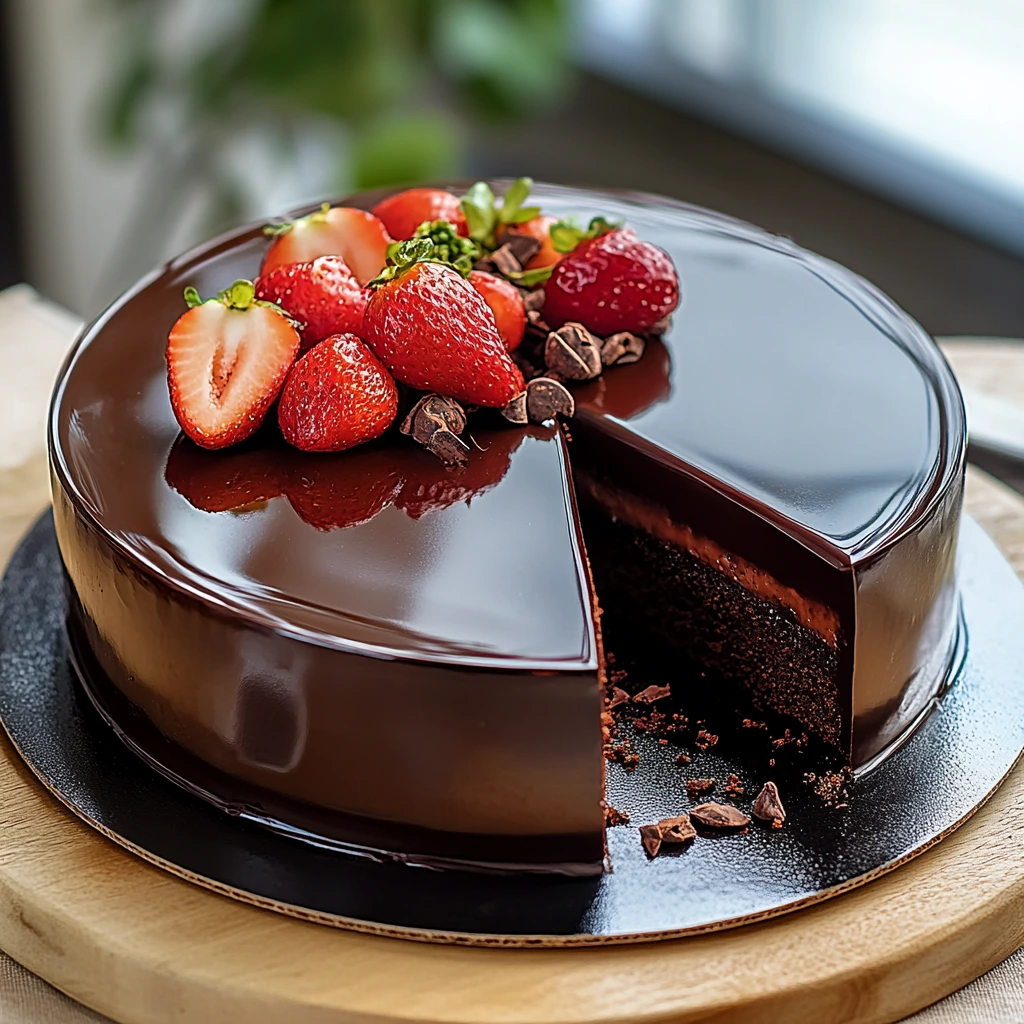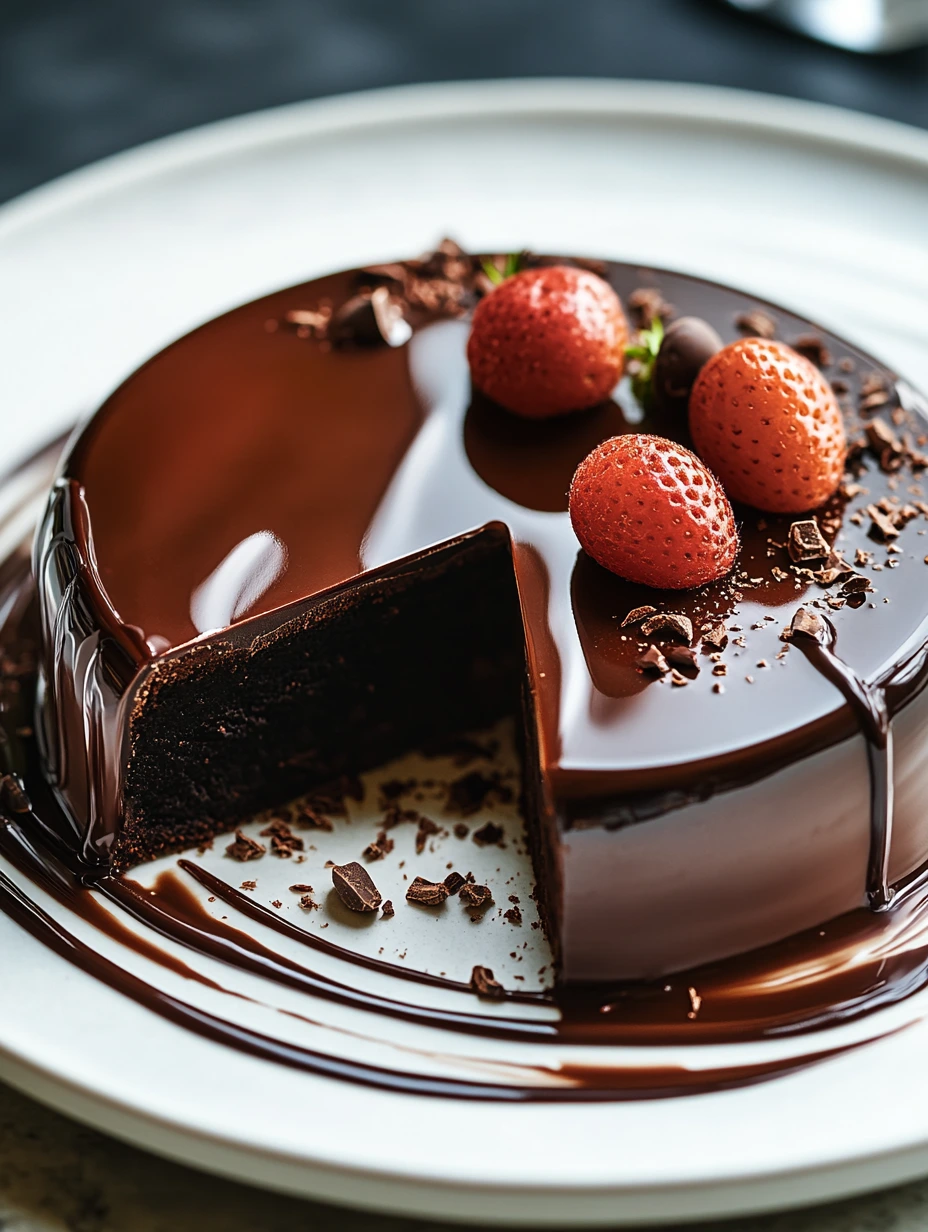 Pin it
Pin it
This chocolate mirror glaze can turn any regular dessert into a pro-level pastry creation with its super shiny finish.
When I first made this glaze for my niece's birthday, everyone thought I'd bought the cake from a fancy bakery. Since then, it's become my go-to for special occasions.
Ingredients
- Dark chocolate 200g: go for quality baking chocolate with 60-70% cocoa for a deeper flavor
- Sugar 100g: regular white sugar works best to keep the shine
- Water 100g: filtered water gives you the best results
- Heavy cream 100g: pick one with at least 30% fat content for a silky texture
- Gelatin powder 10g: this creates the perfect texture but you can swap it for agar-agar if you want a vegetarian option
- Corn syrup 1 tablespoon: optional but helps create that outstanding shine
Step-by-Step Instructions
- Getting the gelatin ready:
- Put the gelatin powder in 50g of cold water in a small bowl. Stir gently with a spoon and let it sit for about 5 minutes. You'll see the gelatin swell up and soak up the water, forming a jelly-like mass. This step really matters if you want to avoid lumps in your final glaze.
- Making the glaze base:
- Pour the sugar, water and cream into a thick-bottomed pan. Heat on medium while constantly stirring with a silicone spatula so nothing sticks. Keep going until you see tiny bubbles forming around the edges, but don't let it boil. The best temperature is just before boiling point.
- Adding the gelatin:
- Take the pan off the heat as soon as the mixture starts to simmer. Add the swollen gelatin and stir hard for about a minute until it's completely melted. Make sure no bits are visible so your glaze will be perfectly smooth.
- Mixing in the chocolate:
- Add the finely chopped chocolate to the hot mixture. Let it sit for 30 seconds then gently stir with a spatula until you get an even, shiny texture. The chocolate should be fully melted. For an even smoother result, strain the mixture through a fine sieve.
- Adding corn syrup:
- Pour in the corn syrup and mix carefully to blend it in. The syrup brings extra shine and helps stop crystallization. You'll notice right away how the glaze becomes more glossy after this addition.
- Putting on the glaze:
- Let the glaze cool to about 32°C. The temperature really matters—too hot and it'll be too runny, too cold and it won't flow evenly. Put your cake on a rack over a dish to catch the excess. Pour the glaze in one motion from the center outward for a perfect finish.
 Pin it
Pin it
I fell in love with this glaze during a pastry workshop in Paris. The pastry chef told us that the secret to a successful mirror glaze is getting the application temperature just right. Too cold or too hot, and the magic just isn't there.
Storing the Glaze
You can keep your mirror glaze in the fridge for up to a week in an airtight container. To use it again, warm it gently in a double boiler or microwave in 10-second bursts, stirring between each. Don't let it boil. The ideal temperature for reusing is the same as for the first application, around 32°C. Once glazed, your cake will stay perfect in the fridge for 2-3 days without losing its shine.
Twists and Variations
For a colorful version, add a few drops of gel food coloring after mixing in the chocolate. You can also swap dark chocolate for white chocolate for a milder glaze, or milk chocolate for a sweeter taste. For a firmer glaze that holds up better at room temperature, bump up the gelatin to 12g. You can play with flavors by adding extracts like vanilla, coffee or even a splash of liqueur for an extra fancy touch.
Best Uses
This mirror glaze works wonders on modern entremets, especially mousse-based ones. It beautifully transforms chocolate mousse domes, bavarian creams and cheesecakes. For a showstopping effect, apply it to an entremet placed on a raised stand and let it naturally flow down the sides. The contrast between the glossy glaze and the velvety mousse creates a perfect visual harmony that will wow your guests before they even take their first bite.
Frequently Asked Questions
- → What's the right temperature for pouring mirror glaze?
You'll want your glaze around 32°C when pouring. At this heat, it stays thick enough to create that even mirror effect without running off too much.
- → Can I use milk chocolate instead of dark?
You sure can swap dark for milk chocolate. Just know your glaze will turn out sweeter and lighter in flavor.
- → What can I use instead of gelatin?
For a veggie-friendly option, try agar-agar instead of gelatin. Make sure to follow the specific instructions for agar-agar to get the texture just right.
- → How do I store leftover mirror glaze?
You can keep your glaze in the fridge for a day or two in an airtight container. When you're ready to use it again, warm it gently and bring it back to 32°C.
- → What treats work well with mirror glaze?
Mirror glaze works wonders on lots of sweets - try it on cakes, mousses, bavarian creams, and even smaller treats like cupcakes or eclairs.
